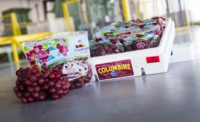Researchers Develop Sustainable Packaging Alternative: Edible Coating That Extends Produce Shelf Life

Image credit: Raccool_studio via Freepik

Image provided by Chungnam National University


To meet the need for sustainable alternatives for food packaging, researchers from Chungnam National University have developed an edible, recyclable coating that can that enhance packaging while extending the shelf life of fruits.
Made of chitosan (CS) and gallic acid (GA), the biofilm coatings can protect fruits from post-harvest degradation by preventing water loss and gas exchange, reducing the need for refrigeration or synthetic preservation.
Chitin, a natural polymer derived from the endoskeleton of crustaceans, is chemically modified to produce chitosan, a nontoxic and biodegradable compound with excellent film-formation abilities. However, certain limitations, including weak barrier and low antimicrobial properties, hinder its potential as a food coating material. To address these limitations, the Chungnam research team incorporated a polyphenolic compound, gallic acid, to produce a CS-GA conjugate. Gallic acid is abundant in plants and is known for its antimicrobial and antioxidant properties.
The study, led by Chungnam National University Professor Won Ho Park, Ph.D., was published in Food Chemistry, and describes the synthesis and characterization of the CS-GA conjugate film. The researchers compared it with chitosan-only films to assess the effects of chitosan’s enhancement with gallic acid, and tested its efficacy on stored mini bananas and cherry tomatoes.
The findings showed that the coating exhibited enhanced mechanical strength, offering protection against food damage during transportation, and improved antioxidant properties, leading to extended shelf life. It also showed improved antibacterial activity against two types of bacteria, confirming its effectiveness against multiple microbial species, and superior UV-blocking capabilities to prevent photo-discoloration and damage. The film also exhibited a high affinity for hydrophobic fruit surfaces, while also facilitating easy washing.
Looking for a reprint of this article?
From high-res PDFs to custom plaques, order your copy today!









